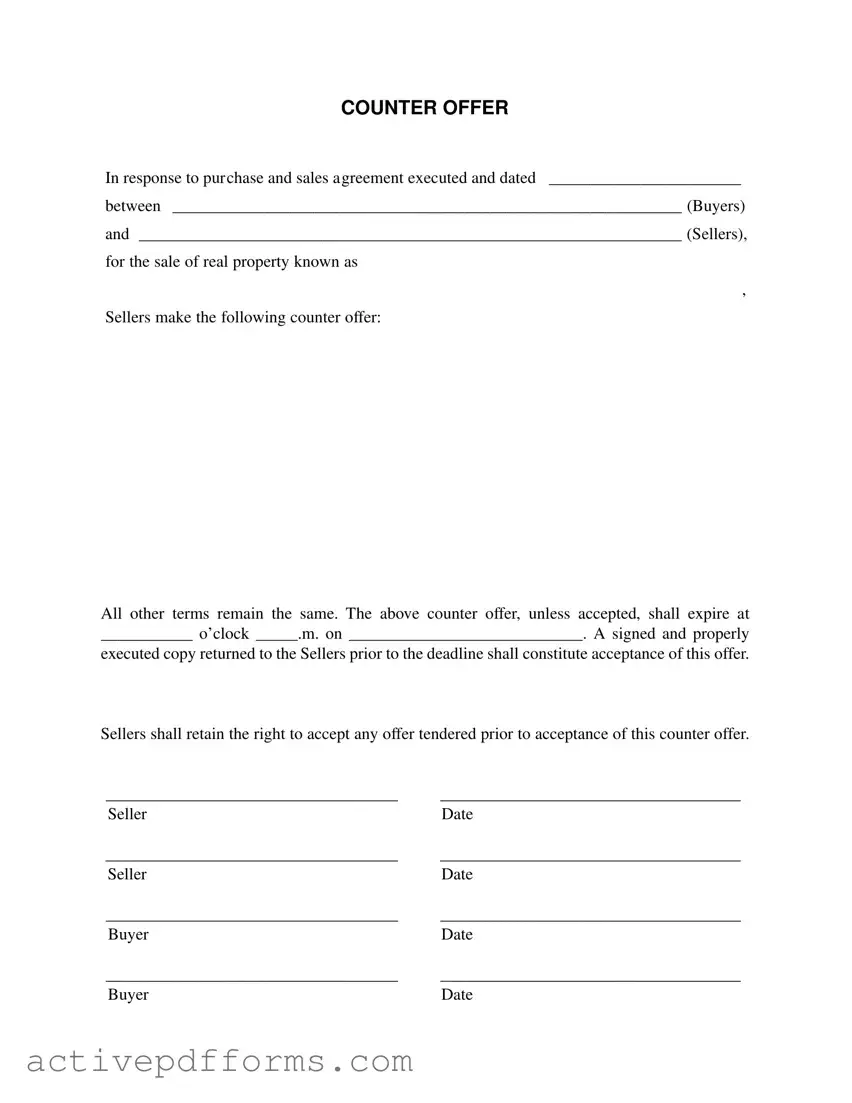- What is a Counter Offer form?
A Counter Offer form is a legal document used in real estate transactions. It's generated by sellers in response to an initial purchase and sales agreement from buyers. This form outlines the sellers' terms, which may differ from the original offer. It's a way to negotiate terms such as price, closing dates, or other conditions before finalizing the sale of real property.
- When should I use a Counter Offer form?
You should use a Counter Offer form after receiving a purchase and sales agreement that you wish to negotiate. If the terms or price don't meet your expectations or needs, this form serves as a formal way to propose your desired terms back to the buyer.
- How do I know if the Counter Offer has been accepted?
Acceptance of the Counter Offer is confirmed when a signed and properly executed copy of the form is returned to the sellers before the expiration deadline mentioned in the document. Ensure all parties, including all listed buyers and sellers, have signed the form to consider it officially accepted.
- What happens if the Counter Offer is not accepted on time?
If the Counter Offer is not accepted by the specified deadline, the offer automatically expires. This means the sellers are free to consider and accept other offers that might be on the table. Communication with the potential buyers is key in case further negotiation is desired.
- Can sellers make multiple Counter Offers to different buyers?
Yes, sellers can make Counter Offers to multiple buyers; however, caution is advised. Each Counter Offer should have its own expiration date and time, giving sellers the right to accept the best offer. Be transparent and communicate clearly to all parties involved to avoid legal complications.
- Do all sellers need to sign the Counter Offer form?
Yes, all sellers listed in the original purchase and sales agreement need to sign the Counter Offer form to make it valid. This ensures that all parties with ownership rights agree to the new terms proposed in the Counter Offer.
- Can terms other than price be negotiated in the Counter Offer?
Absolutely. While price is a common reason for a Counter Offer, other terms such as closing dates, contingencies, and included personal property can also be negotiated. The key is to specify which terms of the original offer are being modified in the Counter Offer.
- What should be done with the Counter Offer form once it is accepted?
Once the Counter Offer form is accepted, it becomes part of the legal agreement between the buyer and seller. You should keep a signed copy for your records. Additionally, it's important to proceed with any necessary updates to the original purchase and sales agreement to reflect the new terms agreed upon.
- Is there a need for a lawyer to review the Counter Offer form?
While not always necessary, having a real estate lawyer review the Counter Offer form can be beneficial. A lawyer can ensure that the terms are clearly stated, legally binding, and in your best interest. They can also provide guidance on any further steps needed to complete the sale transaction according to the newly agreed terms.
